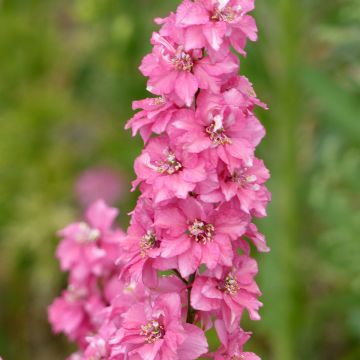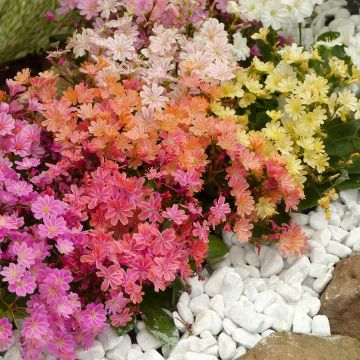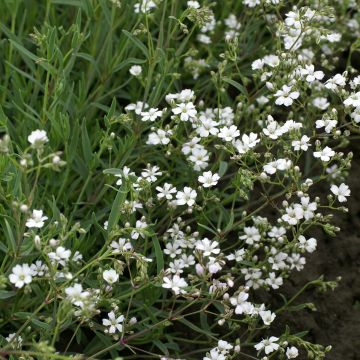
How to sow annual seeds: directly in the ground or in trays?
Tips and advice
Contents
The majority of annual flower seeds : Poppies, Marigolds, Morning Glories, Cosmos, Ipomoea, Nigella… can be sown directly in open ground.
However, sowing in seed trays or pots offers numerous advantages : it allows for earlier flowering, facilitates the establishment of your flowers while saving you the hassle of thinning and weeding.
Discover our tips for choosing your sowing method and our tricks for success.
Sowing in trays or buckets of annual flowers
Why choose to sow your seeds in trays or pots
Sowing in trays or pots has many advantages. It is even highly recommended for certain plants that require a lot of warmth to germinate, such as cobaea, for example, and it allows for optimal germination results.
Sowing your seeds in trays allows you to:
- achieve earlier flowering by artificially creating and advancing the ideal conditions for germination under cover,
- increase your chances of success (with varieties known to be difficult or if you are sowing a bit late) by using suitable substrate and controlling the temperature and humidity of the compost,
- obtain plants that can be placed exactly where you want in your flowerbed (ideal for filling any gaps),
- avoid potential thinning in case of overly dense sowing,
- avoid weeding that sometimes results from sowing directly in the ground, as strong plants can be immediately mulched.
How to sow in trays or pots
Sowing in trays, under cover, is done early, from February to mid-April. You can also sow in pots outdoors, following the direct sowing calendar.
The ideal germination temperature varies greatly depending on the species. It is generally between 15 and 25 °C. This information is on the seed packet, and we advise you to refer to it systematically. It is based on this recommended temperature that you will choose the best place to sow your flowers: warm, at home or in a heated greenhouse or conservatory, outdoors, under a frame or a mini-greenhouse, well protected from the cold at night.
Step 1) Prepare your trays and pots:
- Prepare your containers (trays, pots) by filling them two-thirds full with a special sowing compost. Ensure that the bottom has small drainage holes to allow excess water to escape.
- Moisten the substrate with a light watering,
- Lightly compact with a trowel (or with your fingers).
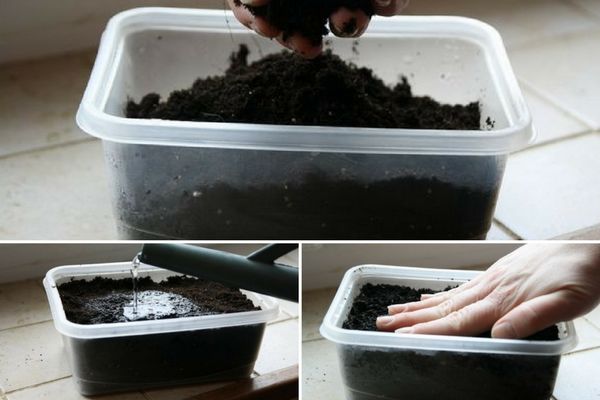
Tip: polystyrene trays are perfect for sowing, and they can easily be found at fishmongers.
Step 2) Sow your seeds:
- Draw, with a stick or a knife, furrows that are more or less deep, depending on the size of your seeds and the instructions on the packet.
- Place the seeds, leaving at least 1 cm between each seed. Do not sow too densely: this would hinder proper seed emergence, and you would have to sacrifice a good number of them, which would promote damping off and etiolation (plants that grow long and spindly).
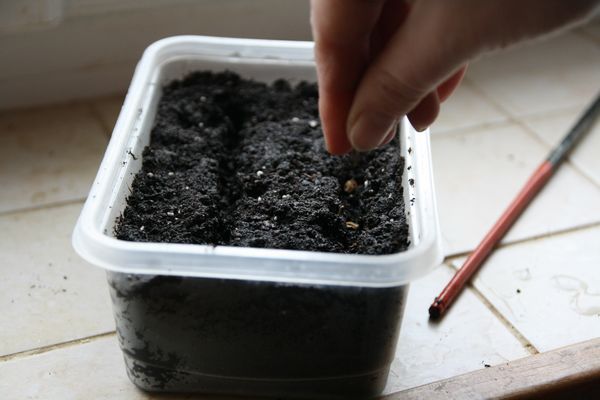
Sow your seeds.
- Cover the seeds with compost (or with vermiculite) and lightly compact with the trowel.
- Water with a very fine spray, using a sprayer, taking care not to disturb the seeds.
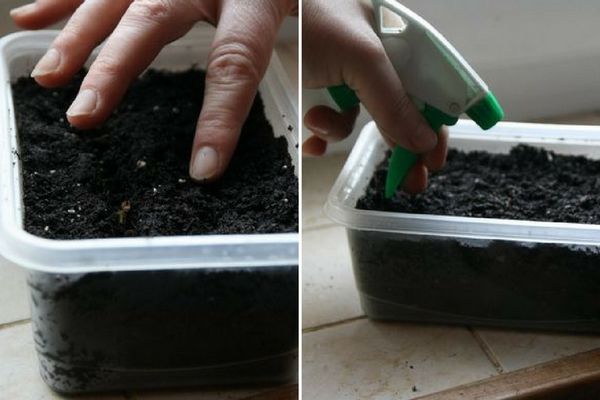
Cover the seeds with compost and then water with a sprayer.
Tip: to prevent damping off, a disease caused by a fungus, cover the compost with a thin layer of finely crushed charcoal.
Step 3) Once sowing is done:
- Place the tray on a windowsill, in your conservatory, in a greenhouse, or under a frame.
- To improve results, cover the tray with a glass, but remember to ventilate regularly by lifting the glass to avoid creating a too humid climate, which is favourable to damping off. You can also use a mini-greenhouse.
- Keep the substrate moist, but not overly wet, until emergence.
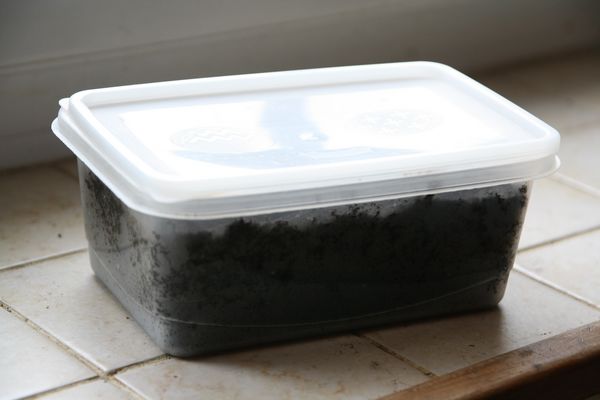
Tip: if you are sowing species that require a lot of heat, use a heated propagator or place your pot on a heat source, such as a water radiator.
Step 4) When the seedlings appear:
- Remove the glass, at least during the day.
- Place your seedlings in a bright location to prevent your young plants from becoming leggy.
- Beware of the afternoon sun: too direct, it can be fatal to young seedlings placed too close to a window.
Tip: if your young plants are stored in a place that is quite cold at night (frame, conservatory…), cover them with the glass in the evening to keep them warm.
Step 5) Once your plants are well developed:
- Transplant them carefully into pots when the seedlings have two true leaves (in addition to the cotyledons, which are not considered true leaves),
- You can place your plants in a cooler location, but keep them protected from frost.
- Install your plants in the garden after the Ice Saints (mid-May) when all risk of frost has passed.
Tip: to obtain strong plants, they need to be hardened off! To do this, let them get some fresh air and sunlight (not scorching) by taking them outside whenever the weather permits.
Another method: Fertiss clumps, favoured by professionals, for easy sowing and propagation.
Direct sowing of annual flowers in open ground
Why choose to sow your seeds directly in the ground
Direct sowing has two major advantages: it is simple and quick. This method of sowing annual flowers is particularly suitable for easy varieties such as nigellas, cosmos, and if you wish to create an entire bed of annuals.
When and how to sow in the ground
Direct sowing is done once all risk of frost has passed, generally after 15 May. Depending on the regions, this can be from mid-March to June, when the average ambient temperature reaches around 15 °C. The soil should ideally be already warmed, moist, and sunny.
Step 1) Prepare the soil:
- Using a rake, a hoe, or a hand trowel, carefully weed the chosen surface for sowing,
- Work the soil by raking with a claw or rake the surface to achieve fine soil to a depth of about 6 mm.
- If the soil is heavy, mix the topsoil with a blend of 1/3 sand and 2/3 potting soil.
Tip: do not work your soil if it is too wet, as you will struggle to create a fine seedbed to properly accommodate your seeds.
Step 2) Sow:
- Sow your seeds by scattering them, taking care to distribute them evenly.
- Gently cover with a rake and then lightly “firm” with the flat part of the rake so that the seeds adhere well to the soil.
- Carry out an initial watering, with a fine spray to avoid displacing the seeds, using a watering can or hose.
Tip: if you are sowing particularly fine seeds, mix them with sand or dry coffee grounds
Step 3) Support seedling emergence:
- Remember to water if it is dry, so that the soil does not dry out: some moisture is necessary for the proper germination of the seeds.
- After 10 to 14 days, you can thin out by removing the less developed plants, leaving 15 cm between two plants.
Tip: did you love your flower bed? After flowering and when the flowers are dry, shake them to encourage spontaneous sowing for the following spring!
Discover other Flower seeds
View all →Available in 1 sizes
Available in 1 sizes
Available in 1 sizes
Available in 1 sizes
Available in 1 sizes
Available in 1 sizes
Available in 1 sizes
Available in 1 sizes
Available in 1 sizes
Available in 1 sizes

Going further...
Discover our advice sheet: 10 easy annual flowers to sow!
- Subscribe!
- Contents
































